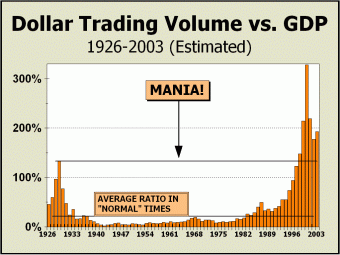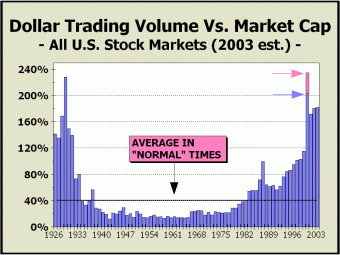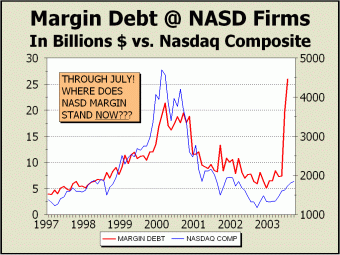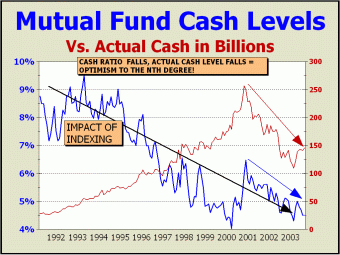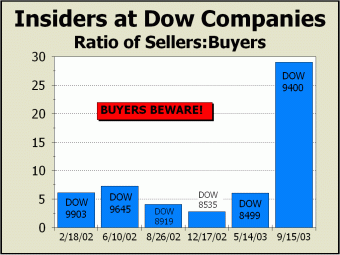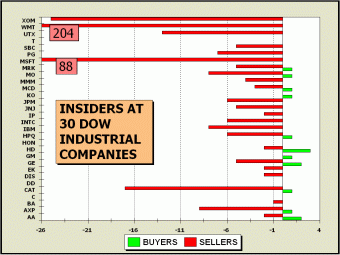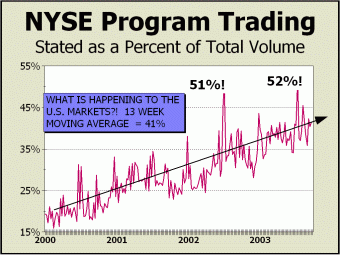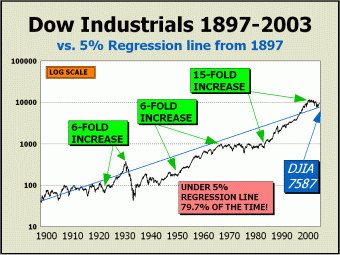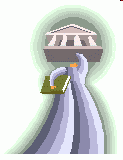
|
DATED OCTOBER 2, 2003 A SPECIAL REPORT BY ALAN M. NEWMAN, EDITOR LONGBOAT GLOBAL ADVISORS CROSSCURRENTS |
| When I commenced
this series of articles back in January of 1999, I was positive that the
country was immersed in the greatest stock market mania of all time.
My father had been a broker at the very top in 1929 and I had heard all
the stories about the madness and the sad déneumont. Clearly,
what was underway in the U.S. in 1999 was no different. But in fact,
it was. The formerly greatest stock market mania in 1929 was unwound
rapidly with the Great Depression as stocks, measured by the Dow Jones
Industrials, sank 89% in less than four years. In 1929, stocks were
a big business, but they were outweighed in importance by America's burgeoning
influence in manufacturing. Steel, autos and textiles eventually
conspired to lift the economy back to a more normal level and after years
of pain, stocks stabilized and another bull market emerged. It was
another generation until the next super bull market began but the depression
had ended. Today is another story entirely. America is no longer
the world's leader in manufacturing and is now even exporting service jobs
as rapidly as possible. The one saving grace; the one category in
which the U.S. is still the undisputed leader and vaunted expert is the
manufacture of financial products and the marketing and advertising of
those products as indispensable.
This has enabled the survival of the economy. It has also enabled Act II of the greatest stock market mania of all time.
If America can do anything better than any other country, it is to promote financial products of every kind and description, but in particular, stocks. We will save our analysis of the derivative arena for another issue, and for now are fully committed to illustrating the far reaching nature of the current stock market mania, which is actually an extension of the bubble that began to build slowly in 1995 - until it really began to take off in the late nineties. There is only one way to look at the first picture we present below. Stocks are the biggest business there is. Nothing is bigger. Even at the very lowest point since the enormous 2000 peak in prices, Dollar Trading Volume never traded below $1.70 for each dollar generated in the purchase or sale of goods and services in the domestic economy. And the rally since March has now enabled DTV to surge to $1.92, very close to where the indicator was at the end of 1999. In retrospect, there is not a human being alive who would argue against the point that the country was immersed in a veritable mania at the end of 1999. Can anyone argue that point now? In fact, the bubble did not burst. It only took a time out. The greatest stock market mania of all time is STILL in progress. In what we term "normal" times - those years that are not part of a mania - the stock market tends to trade about 40% of total market capitalization during the course of a year. Folks decide prices are attractive, they buy. Others decide price are too high, they sell. Obviously, since bull markets proliferate time wise over bear markets, we can infer that the high range for "normal" probably extends far past the average of 40%. Since activity rises above 100% of market cap in so few years, this particular assumption may be as good as any other for determining "abnormal" or excessive. Note that after the 1929 crash, DTV vs. market cap contracted rapidly below 100% and remained there until, of all years, 1987, which was highlighted by an enormous crash. For those of you who may not remember the Crash of '87, the Dow Industrials fell from 2722 in August to as low as 1738 in October, a 36.1% slide of which 23.1% was accomplished in only one day! What marks the current environment as a continuation of the mania is the steady increase in trading since the initial drop in 2001. Despite a 50% drop
in the S&P 500 and a 76% decline in Nasdaq,
Act I has simply been followed by Act II.
Since we first published our Chart of the Year privately for our subscribers, it has seen exposure in Alan Abelson's column in Barron's, in Kate Welling's newsletter welling@weeden, the Elliott Wave Financial Forecast, edited by Steve Hochberg and Pete Kendall, Germany's Der Spekulant, Jim & Mary Puplava's Financial Sense and possibly other places we just haven't caught up with yet. Below, what subscribers saw first, reprinted from the September 22nd issue of Longboat Global Advisors Crosscurrents: Sometimes a chart comes down the pike that is just so astounding, you have to sit up and stare at it for a few moments in order to grasp just how meaningful it is. Typically, we cite such a picture as our “Chart of the Year” and feature it on page one. Today is no exception. What you see here today is a picture that is clearly worth a thousand words. Trouble is, we wrote those words back in late 1999 and early 2000, when we penned extensively about the greatest stock market mania of all time. Déjà Vu? Before delving further, we hasten to explain that the data for the picture before you comes from NASD firms, not the New York Stock Exchange. Still, it is patently obvious that the mania has taken a great leap forward - towards an abyss of intolerable risk. The rise in margin has been so emphatic that the NASD was compelled to issue an official "warning" about the dangers of margin on Monday. Mary Schapiro, NASD vice chairman and president of regulatory policy and oversight, cited a "precipitous increase" in margin use and warned of the "consequences that can result." The chart speaks for itself, illustrating an explosion in risk taking as stock prices - ironically and particularly Nasdaq's more risky issues - improved into the summer. Given that August and September are not yet pictured, we can only guess what level of risks speculators are currently suffering. We are somewhat mollified that total margin debt including the NYSE is not yet at a new record, but then again, without the benefit of results from August & September, we are only making an assumption that might conceivably be wrong - heaven forfend! Given that margin debt is exploding at the same time that mutual funds are spending their cash reserves to one of their lowest levels ever, it would appear that risks could conceivably be as high now as they were in March of 2000. There can be no doubt that the greatest stock market mania of all time is still very much in progress One of the most emphatic reasons why we believe the mania is ongoing and that we are simply in Act II, is illustrated by absolute and relative cash levels of mutual funds pictured below right. Even the fund manager who believes stocks are ludicrously overvalued cannot afford his own opinion. Index funds - by definition - are always fully invested in the index and index funds now account for more than 10% of all stock assets. If prices are rising, any fund with cash reserves must choose better performing stocks or perforce, must under perform the index. For instance, if a fund carries a cash reserve equal to 5% of assets and the market rises 15%, the fund will lose on average, 75 basis points to an index fund. In this business, 75 basis points of under performance is a disaster. This is clearly the principal reason why the cash-to-assets ratio has declined significantly since indexing began taking a huge hold on investor’s assets. The is clearly the principal reason why the cash-to-assets ratio continued to decline even as prices were declining into the March 2003 low. It was one thing when the ratio of cash-to-assets bottomed at the end of 1999 and the beginning of 2000 as prices soared. It was quite another thing when the ratio of cash-to-assets bottomed in February 2003, coincident with a major market bottom. Since when is a major stock market bottom associated with a low point in the level of cash reserves? Since indexing, when active managers realize they cannot compete otherwise. Incredibly, as the index performs even better versus active management because more money is thrown at it, still MORE money is thrown at it. Indexing becomes a cycle of moronic simplicity. The impact, clearly visible in our picture - is lower cash reserves on both an absolute and relative basis, illustrating rising risk for those who are long the markets. Thus, we have a two edged sword; not only is margin exploding for the most speculative issues but the one area that can support the markets in a price correction - cash reserves - is rapidly dwindling. Prices may be lower than they were in March 2000 but risks are just as high.
Until we saw the data on the NASD website for margin, the picture at left below was destined to our Chart of the Year. This article, as well as some others you see on this site, was published first in our newsletter, Longboat Global Advisors Crosscurrents. If you haven't seen the newsletter, you should. If you are not a subscriber, you will probably not find a better way to spend 46 cents a day. Every once in a while, we tally where insiders stand in order to get a better grasp on where stock prices might be headed. The rationale is easy - if insiders are gobbling up their own shares or are loathe to sell, it would seem a fair bet that business - and perhaps even prices - are about to pick up. On the other hand, if insiders are unloading their shares in droves, it would appear to be a decent bet that things are not going as well as stock prices imply they are. Regarding the 30 Dow Jones Industrial issues, we have been through this exercise a number of times in the last year-and-a-half and although we have always seen sellers proliferate, the current tally is so far beyond what we have ever seen before, that even a second glance does not do justice to the numbers. This is phenomenal! According to the data from the last six months provided by S&P Marketguide, insiders at the Dow companies are falling all over themselves to ditch their own shares and are doing so at the most rapid rate since we began tallying the numbers. As our next chart shows, going back to February 2002, the ratio of sellers to buyers ranged from 2.8 to 7.3. It's interesting to note that the former high ratio occurred on June 10, 2002 when the Dow traded at 9645. Exactly four months later, the tape showed the Dow trading as low as 7197, a 25.4% collapse. The Dow's seller/buyer ratio has now ballooned
to 29,
As our right-hand chart illustrates, buyers are not particularly visible. Since we last ran the numbers back in mid-May, buyers have contracted from 25 to 15 and sellers have expanded from 151 to 435! All too often, Microsoft has acted as an outlier, as sales by Bill Gates and dozens of other Softee employees have tipped the scales. This time around, Gates & group take second place to the very busy folk at Walmart, who number 204 sellers. And oh yes, zero buyers. We have also kept track of total shares bought and sold and are eager to report that the overall shares sold/shares bought ratio peaked at 382-1 back in February 2002. It fell sharply to 92-1 in June ‘02 and 62-1 in August ‘02 before turning the corner. The ratio registered 105-1 in December ‘02, 171-1 back in May ‘03 and now once again, stands at a lofty 337-1. We'll have to keep our bull hat on the shelf.
In the quest for fairness, we must reveal that the same exercise applied to the top ten Nasdaq issues produced nothing quite as astounding as our Dow view, but Nasdaq stocks typically see sellers proliferate in fair quantity. However, the seller/buyer ratio at 56.2-1 was almost double that of the Dow and the ratio of shares sold to shares bought was a cool 1220-1, near the high end of the range for all of our prior tallies. They don’t want their own shares either. Neither do we.
We would guess that Richard Grasso's crowning achievement in his stewardship of the New York Stock Exchange was the rapid growth of Program Trading. By mid-1995, when the mania had already gotten underway, a good day for programs was 15% of total volume, which averaged about 343 million shares at the time. Thus programs may have accounted for 51.5 million shares on a good day. By 1997, programs were averaging about 17% of volume and volume was averaging about 550 million share per day, so programs accounted for perhaps 93.5 million shares per day. By 2000, programs accounted for 224 million shares per day. By 2001, they accounted for 342 million shares per day. By 2002, they accounted for 469 million shares per day. Thus far in 2003, programs account for about 546 million shares per day, about as much as total NYSE volume ran in 1997! Growth in Program Trading has been exploding. Our concern with programs is that we cannot pin any vestige of sentiment on their implementation. Transactional velocity in the market that is driven without sentiment or the benefit of the fundamental analysis of individual companies - like indexing - destroys the pricing efficiency of individual shares. As you can clearly see, Programs now comprise 41% of NYSE volume. Is the small investor important anymore? Does the NYSE even care? And when will the public finally stand up and ask for an accounting of how programs move the market and affect the small investor? At 50% of total volume. 70%? 90%? This is a major trend and it is clearly in place. At some point, the involvement of the individual investor will not matter. The way we see it, in a mania, what matters is the mania. The public be damned. We have shown our regression chart quite a few times over the life of our Pictures of a Stock Market Mania, and we suggest you take a quick look at the next-to-last chart at our archived update presented back in July 2002 at Dow 8191. We postulated an eventual return to Dow 7151 and indeed, the Industrials came within 46 points of the target, printing as low as 7197 on October 10, 2002. However, the Dow has yet to trade below our regression line, a circumstance we fully expect to occur at some point. Not only do we expect it to occur, we expect that the Dow may remain UNDER the regression line for an extended period. Given that the Industrials have been under the 5% regression line for nearly 80% of all period measured over the life of the chart, we do not see our expectations as bearish. Our expectations are for the norm! Although the regression line is now at 7587 and rises a bit each day, there is no earthly reason why prices must remain above the line. Given the extent of the super bull market and subsequent mania, driving prices up 15-fold, even a rather large dip below the line could be viewed as typical. Once the Dow trades below the regression line, it may remain there for years.
We were wrong on the extent of the rally from the March lows. Almost immediately after the market made its bottom on March 10, 2003, we had offered a high side forecast for the remainder of the year on this site for Dow 9200-9600 /// SPX 955-999 /// Nasdaq Composite 1500-1600. Our subsequent adjustments lowered our upside Dow target to Dow 9400, upped our upside target for the SPX to 1015 and upped our upside target for Nasdaq to 1776. These targets were not terribly far away, however, our big mistake was that we stressed much higher odds for our low side forecasts and they missed the mark by a mile. The low side forecast was Dow 6400 - SPX 680 - Nasdaq 1000-1100. This has been our worst forecasting error ever. What happened? Act II of the greatest stock market mania of all time. Although subscribers to Longboat Global Advisors Crosscurrents have seen "easier" intermediate targets in place for several weeks, all of our long term analysis still points to the lower Dow 6400 - SPX 680 - Nasdaq 1000 as not only possible, but quite probable. However, these targets will likely play out over a longer time frame than we previously imagined - most likely in 2004. The two strongest emotions in the market are fear and greed. As action since March has conclusively proved, greed still has the upper hand. But if we are correct in our analysis, Act II is now ending and fear will once again - finally - come into vogue. The curtain should soon fall for Act II.
Intermediate Term Targets for the remainder of 2003: Dow 8500 /// SPX 900 /// Nasdaq Composite 1540-1630 Our upside targets
have all been exceeded
Long Term Targets for the bear market - odds now favor 2004: Dow 6400 /// SPX 680 /// Nasdaq 1000-1100 THE CONTENTS OF THE ENTIRE WEBSITE ARE COPYRIGHT 2003 ALAN M. NEWMAN Alan M. Newman, October 2, 2003 All information on this website is prepared from data obtained from sources believed reliable, but not guaranteed by us, and is not considered to be all inclusive. Any stocks, sectors or indexes mentioned on this page are not to be construed as buy, sell, hold or short recommendations. This report is for informational and entertainment purposes only. Longboat Global Advisors, Alan M. Newman and or a member of Mr. Newman’s family may be long or short the securities or related options or other derivative securities mentioned in this report. Our perspectives are subject to change without notice. We assume no responsibility or liability for the information contained in this report. No investment or trading advice whatsoever is implied by our commentary, coverage or charts. |
